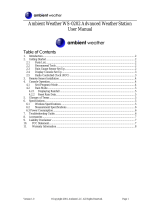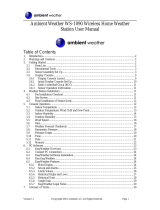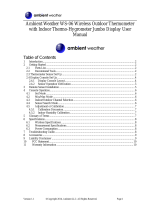Page is loading ...

Version 2.7 ©Copyright 2019, Ambient LLC. All Rights Reserved.
Page 1
WS-2801A Advanced Color Wireless
Weather Station User Manual
Table of Contents
1 Introduction ..................................................................3
1.1 What’s New with the WS-2801A ..........................4
1.2 Features .................................................................4
2 Quick Start Guide .........................................................5
3 Getting Started ..............................................................5
3.1 Parts List ................................................................6
3.2 Recommend Tools .................................................7
3.3 Thermo-Hygrometer Sensor Set Up ......................7
3.4 Display Console ..................................................10
3.4.1 Display Console Layout ...............................10
3.4.2 Display Console Set Up................................12
3.4.3 Display Console Set Up................................13
3.5 Sensor Operation Verification .............................16
3.6 Sensor Placement ................................................17
3.7 Best Practices for Wireless Communication .......18
4 Console Operation ......................................................20
4.1 Set Mode .............................................................20

Version 2.7 ©Copyright 2019, Ambient LLC. All Rights Reserved.
Page 2
4.1.1 Time Zones ...................................................24
4.2 Barometric Pressure ............................................25
4.2.1 Barometric Pressure History .........................25
4.2.2 Relative Pressure Calibration .......................26
4.2.3 Relative vs. Absolute Pressure .....................26
4.3 Dew Point ............................................................27
4.4 Multiple Channel Selection and Scroll Mode ......27
4.5 Alarms .................................................................28
4.5.1 View Alarm Time .........................................28
4.5.2 Time Alarm Settings Mode ...........................28
4.5.3 Cancelling the Alarm ....................................29
4.5.4 Low Temperature Alarm ...............................30
4.6 Calibration ...........................................................30
4.7 Max/Min Mode....................................................34
4.8 Other Console Features .......................................35
4.8.1 Display Brightness........................................35
4.8.2 Weather Forecasting .....................................35
4.8.3 Weather Forecasting Description and
Limitations.............................................................36
4.8.4 Moon Phase ..................................................37
4.8.5 Pressure Tendency Arrows ...........................39
4.8.6 Rate of Change of Pressure Graph ...............39
4.8.7 Resynchronizing Lost Sensor .......................40

Version 2.7 ©Copyright 2019, Ambient LLC. All Rights Reserved.
Page 3
4.8.8 Factory Reset ................................................41
5 Glossary of Terms .......................................................42
6 Specifications .............................................................43
6.1 Wireless Specifications ........................................43
6.2 Measurement Specifications ................................44
6.3 Power Consumption ............................................45
7 Troubleshooting Guide ...............................................45
8 Accessories .................................................................48
9 Liability Disclaimer ....................................................49
10 FCC Statement .........................................................50
11 Warranty Information ...............................................51
12 California Prop 65………………………………….52
1 Introduction
Thank you for your purchase of the Ambient Weather
WS-2801A Wireless Color Weather Station. The
following user guide provides step by step instructions
for installation, operation and troubleshooting. To
download the latest manual and additional
troubleshooting tips, please visit:
http://www.AmbientWeather.net/help

Version 2.7 ©Copyright 2019, Ambient LLC. All Rights Reserved.
Page 4
1.1 What’s New with the WS-2801A
The WS-2801 only supported one remote wireless sensor.
The WS-2801A supports up to three wireless remote
sensors.
The WS-2801A adds scroll mode, which allows you to
view all three channels without pressing any buttons.
1.2 Features
The WS-2801A features:
• Wireless outdoor and indoor humidity (%RH)
• Wireless outdoor and indoor temperature (°F
or °C)
• Records min. and max. humidity
• Records min. and max. temperature
• Barometric pressure (inHg or hPa)
• Weather forecast
• Radio controlled (WWVB) automatic date and
time or manual date and time
• 12 or 24-hour time display
• Perpetual calendar
• Time alarm with snooze
• Moon phase
• LED color backlight
• Wall hanging or free standing
• Supports up to three wireless remote sensors

Version 2.7 ©Copyright 2019, Ambient LLC. All Rights Reserved.
Page 5
2 Quick Start Guide
Step
Description
Section
1
Power up Remote Sensor
3.3
2
Power Up Display Console
3.4
3
Set Up or Program Display Console
4.1
4
Install Sensor
3.6
5
Calibrate Barometer
4.2 and
4.6
3 Getting Started
The WS-2801A weather station consists of a display
console (receiver), thermos-hygrometer sensor and AC
adapter.
Note: The power up sequence must be performed
in the order shown in this section (remote transmitter
first, display console second) to properly synchronize the
remote sensor to the console.

Version 2.7 ©Copyright 2019, Ambient LLC. All Rights Reserved.
Page 6
3.1 Parts List
QTY
Item
Image
1
Display Console
(WS-2801A-C)
Frame Dimensions
(LxHxW): 6.36 x 3.39 x
0.86”
(161.5 x 86 x 21.5 mm)
1
Thermo-hygrometer
transmitter (WH32M)
Dimensions (LxHxW):
4.80 x 1.57 x 0.71”
(122 x 40 x 18 mm)
1
Manual
1
Power Adapter
Figure 1

Version 2.7 ©Copyright 2019, Ambient LLC. All Rights Reserved.
Page 8
1. BEFORE inserting the batteries, switch the
channel switch to the appropriate channel. If
you have one sensor, set the switch to Channel 1.
If you have two sensors, set the second sensor to
Channel 2. If you own three sensors, set the
third sensor to Channel 3.
2. To change the temperature units of measure,
press the ºC/ºF button.
3. Insert two AA batteries.
4. After inserting the batteries, the remote sensor
will display temperature and humidity and
channel number on the display, as shown in
Figure 3.
1 Temperature
2 Temperature Units of
Measure
3 Channel Number
4 Humidity
Figure 3
5. Close the battery door.

Version 2.7 ©Copyright 2019, Ambient LLC. All Rights Reserved.
Page 9
Note: We recommend lithium batteries for cold
weather climates, but alkaline batteries are sufficient
for most climates. We do not recommend
rechargeable batteries. They have lower voltages, do
not operate well at wide temperature ranges, and do
not last as long, resulting in poorer reception.
Note: If the incorrect channel number is selected,
change the channel number switch on the back of
the sensor, and remove and reinsert the batteries for
the change to take effect.

Version 2.7 ©Copyright 2019, Ambient LLC. All Rights Reserved.
Page 11
1. Daylight Savings Time
14. Outdoor humidity
2. Radio controlled
reception
15. Outdoor humidity
3. Time
16. Min indoor humidity
4. Week day
17. Max indoor humidity
5. Date
18. Min indoor temperature
6. Moon phase
19. Max indoor temperature
7. Pressure rate of change
20. Indoor temperature
8. Barometric pressure
21. Min outdoor temperature
9. Barometric pressure
trend arrow
22. Max outdoor temperature
10. Sensor channel number
23. Outdoor temperature
11. Outdoor humidity
24. Transmitter signal strength
12. Min outdoor humidity
25. Weather forecast icon
based on barometer
13. Max outdoor humidity

Version 2.7 ©Copyright 2019, Ambient LLC. All Rights Reserved.
Page 12
3.4.2 Display Console Set Up

Version 2.7 ©Copyright 2019, Ambient LLC. All Rights Reserved.
Page 13
Figure 5
3.4.3 Display Console Set Up
Place the remote thermo-hygrometer about 5 to 10 feet
away from the display console (if the sensor is too close,
it may not be received by the display console).
1. Insert the power adapter into the power jack of the
console, and plug in the adapter. The LCD display
will beep once and then light up. The brightness
selection is set to high when plugged into the

Version 2.7 ©Copyright 2019, Ambient LLC. All Rights Reserved.
Page 14
adapter.
2. Remove the battery door on the back of the display.
Insert three AAA (alkaline or lithium, avoid
rechargeable) batteries in the back of the display
console. Looking at the back of the unit (left to
right), the polarity is (-) (+) for the top battery, (+) (-)
for the middle battery and (-) (+) for the bottom
battery.
Note: To avoid permanent damage, please
take note of the battery polarity before inserting
the batteries.
3. Replace the battery door, and fold out the desk stand
and place the console in the upright position, as
shown in Figure 5.
Note: The batteries are intended for back-up
power only. The backlight will remain on for 5
seconds when on back up battery power only. Only
when you use power adapter it will the back-light be
continuously on.
4. After initialization, the console will instantly display
indoor temperature, humidity, barometer, moon

Version 2.7 ©Copyright 2019, Ambient LLC. All Rights Reserved.
Page 15
phase, date and time. The remote search icon will
turn on:
Do not touch any buttons until the remote sensor
reports in, otherwise the remote sensor search mode
will be terminated and the search icon will turn off.
When the remote sensor data has been received, the
console will automatically switch to the normal
mode, and all further settings can be performed.
3.4.4 Radio Controlled Clock (RCC)
Your console is equipped with the Radio Controlled
Clock (RCC). The icon WWVB will appear above the
time to signify this.
The RCC is received by the wireless transmitter, and
passed to the console. After the remote sensor is powered
up, the sensor will transmit weather data for 30 seconds,
and then the sensor will begin radio controlled clock
(RCC) reception.
During the RCC time reception period (maximum 10
minutes), no weather data will be transmitted to avoid
interference.

Version 2.7 ©Copyright 2019, Ambient LLC. All Rights Reserved.
Page 16
If the signal reception is not successful (normally during
the day due to solar interference), the sensor search will
be cancelled, the outdoor temperature and humidity will
update as normal, and the RCC search will automatically
resume every two hours until the signal is successfully
captured. The regular RF link will resume once RCC
reception routine is finished. In some locations, RCC
reception may take a couple of days to receive the signal.
The temperature and humidity data will continue to
transmit during this period.
Once the radio controlled time is received, the RCC
reception icon will turn on (reference Figure 4).
3.5 Sensor Operation Verification
Verify the indoor and outdoor humidity match closely
with the console and sensor array in the same location
(about 10’ apart). The sensors should be within 10%
worst case (the accuracy is ± 5%). Allow about 30
minutes for both sensors to stabilize.
Verify the indoor and outdoor temperature match closely
with the console and sensor array in the same location
(about 10’ apart). The sensors should be within 4°F
worst case (the accuracy is ± 2°F). Allow about 30
minutes for both sensors to stabilize.

Version 2.7 ©Copyright 2019, Ambient LLC. All Rights Reserved.
Page 17
3.6 Sensor Placement
It is recommended you mount the remote sensor outside
on a north facing wall, in a shaded area, at a height at or
above the receiver. If a north facing wall is not possible,
choose a shaded area, under an eve.
Direct sunlight and radiant heat sources will result in
inaccurate temperature readings. Although the sensor is
weatherproof, it is best to mount in a well-protected area,
such as an eve.
1. Use a screw or nail to affix the remote sensor to the
wall, as shown in Figure 6.
2. Hang the remote sensor up on string, as shown in
Figure 7.
3.
Note: Make sure the sensor is mounted vertically
and not lying down on a flat surface. This will insure
optimum reception. Wireless signals are impacted by
distance, interference (other weather stations, wireless
phones, wireless routers, TVs and computer monitors),
and transmission barriers, such as walls. In general,
wireless signals will not penetrate solid metal and earth
(down a hill, for example).

Version 2.7 ©Copyright 2019, Ambient LLC. All Rights Reserved.
Page 18
Figure 6
Figure 7
3.7 Best Practices for Wireless
Communication
Wireless communication is susceptible to interference,
distance, walls and metal barriers. We recommend the
following best practices for trouble free wireless
communication.
1. Electro-Magnetic Interference (EMI). Keep the

Version 2.7 ©Copyright 2019, Ambient LLC. All Rights Reserved.
Page 19
console several feet away from computer monitors and
TVs.
2. Radio Frequency Interference (RFI). If you have
other 915 MHz devices and communication is
intermittent, try turning off these other devices for
troubleshooting purposes. You may need to relocate the
transmitters or receivers to avoid intermittent
communication.
3. Line of Sight Rating. This device is rated at 300 feet
line of sight (no interference, barriers or walls) but
typically you will get 100feet maximum under most
real-world installations, which include passing through
barriers or walls.
4. Metal Barriers. Radio frequency will not pass through
metal barriers such as aluminum siding. If you have metal
siding, align the remote and console through a window to
get a clear line of sight.
The following is a table of reception loss vs. the
transmission medium. Each “wall” or obstruction
decreases the transmission range by the factor shown
below.
Medium
RF Signal Strength
Reduction
Glass (untreated)
5-15%
Plastics
10-15%
Wood
10-40%

Version 2.7 ©Copyright 2019, Ambient LLC. All Rights Reserved.
Page 20
Brick
10-40%
Concrete
40-80%
Metal
90-100%
4 Console Operation
Note: The console has four keys for easy operation:
TEMP/+ key, ALARM key, BARO/- key and
SET/CH/CH key. There are four program modes: Set
Mode, Alarm Mode, Calibration Mode and Min/Max
Mode.
Any program mode can be exited at any time by either
pressing the SNOOZE/LIGHT key (on the top of the
display console), or waiting for the 30-second time-out
to take effect.
4.1 Set Mode
The Set Mode allows you to change date, time, units of
measure and other important functions, as referenced in
Figure 8.
To enter the Set Mode, press and hold the SET/CH key
for two seconds (SET/CH + 2 seconds). To advance
each command, press (do not hold) the SET/CH key.
/
















